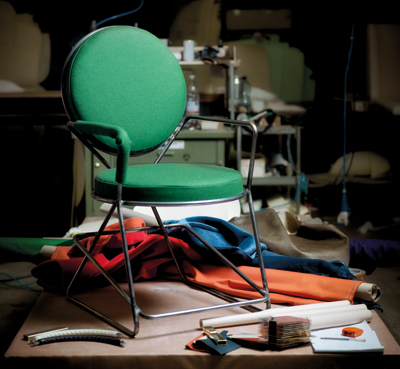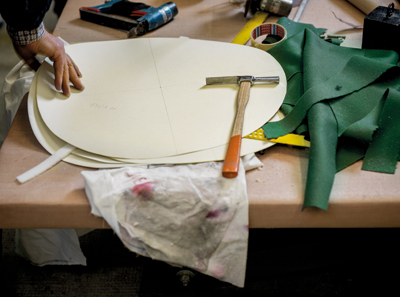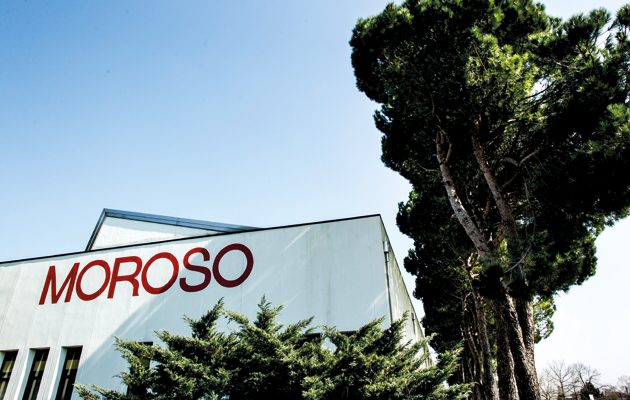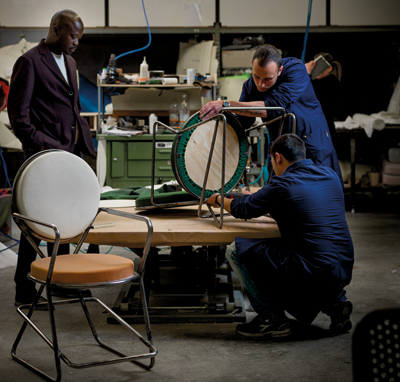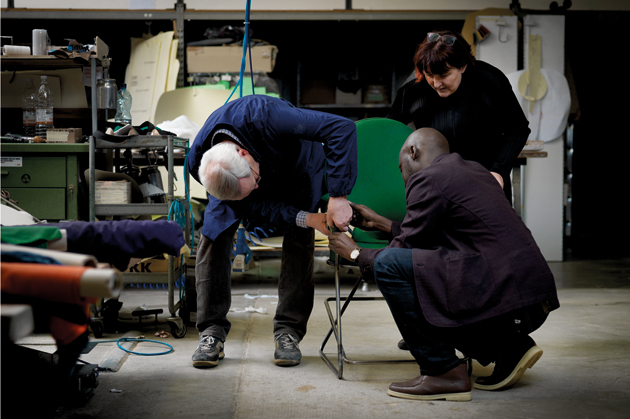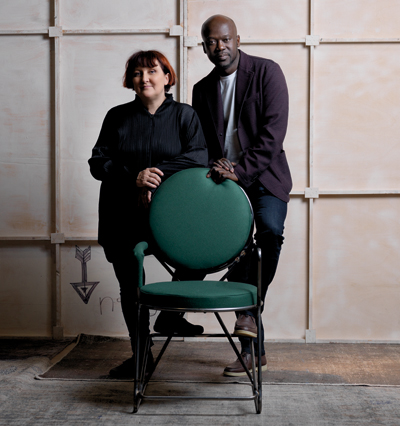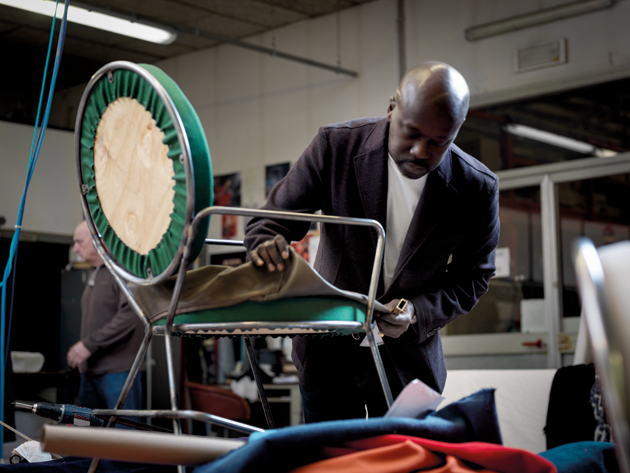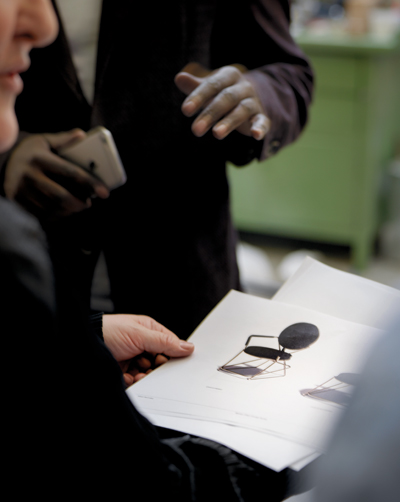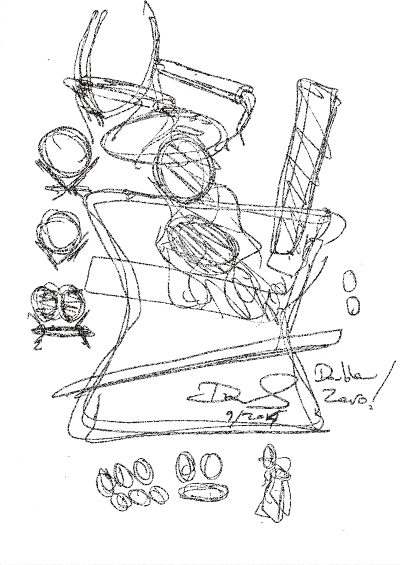|
|
||
|
Just weeks before David Adjaye’s Double Zero chair was unveiled at Milan Furniture Fair, Icon joined the architect at Moroso’s actory in Udine as he and creative director Patrizia Moroso inspected the final prototype – and made some vital last-minute adjustments After lunch, we enter Moroso’s factory here on the outskirts of Udine, the town near the Slovenian border where the Italian firm has been based since 1960. Scattered amid the sewing machines and cutting tables are half-finished products by many of the industry’s biggest names, including Patricia Urquiola, Ross Lovegrove, Tord Boontje and Nendo. As we pass through, individually shaped leather strips are being woven by hand across the curved surface of a Dew seat by the Japanese studio, all held in place by an impressive cluster of large pins resembling a porcupine’s quills. We cross through the “white room”, where foam is sealed into its final shape, and finally arrive at the Prototype Room, in which all Moroso’s products begin their lives. Foam shavings cut from a curvaceous prototype litter the floor and, to one side, a new Ron Arad sofa is hidden, rather perfunctorily, under a white blanket. Foam slabs and card stencils line the walls. Spare space is plastered with old adverts, whether “Seats at Sea” – a reminder of the firm’s shipping heritage – or underwear models posing on Moroso classics. And, underneath the demanding schedule for this year’s Salone, is a newspaper cutting of Angela Merkel looking grumpy as she perches on a Moroso chair. Towards the end of the room, on a lift table, stands the second prototype for David Adjaye’s Double Zero dining chair, which arrived this morning from a local supplier.
The Double Zero prototype at the end of the day This is the forerunner for a family of formal chairs – high stools and dining chairs with and without arms will be exhibited at Milan in only seven weeks’ time – and it will set the parameters for the entire range. The tubular stainless-steel frame comprises the two eponymous circles, which support the back and seat, and a welded structure of arms and legs. The whole is given added rigidity by an angled foot rest – a motif adapted from Adjaye’s Stool 7, designed last year for Standseven, proceeds from which went towards schooling in Sierra Leone. Two blue-coated Moroso employees are rapidly stapling green felt onto a wooden disc – the chair’s back – having just completed the same operation on its padded seat. This is the first time Adjaye, who flew in from London this morning, has seen this new version. He’s a little dejected – having nursed his tiny 3D-printed models of the chair through the flight, he promptly crushed them all on arrival. He cheers up as he shares photos of his 10-day-old son and discusses his designs for the main exhibition at this year’s Venice Biennale, for which Moroso will be providing materials.
Paper stencils for the prototype’s pads The original prototype of the Double Zero chair, inspected by Adjaye two weeks previously, sits on the floor nearby. The diameter of the metal tubing has since been reduced and the arms more fully integrated into the structure. In addition, the foot rest has been lowered and a more generous space created between the arms. The chair’s sitting position draws on Egyptian iconography, but this first attempt was deemed too constricting. Adjaye briefly takes a seat, saying, “People have forgotten this geometry, and the sitting position that results is a fascinating one – it frames you, presenting you formally to the assembled company. But it wasn’t meant to be quite this tight – that’s a mistake.” |
Words John Jervis
Photographs Gianni Antoniali |
|
|
||
|
Moroso’s factory on the outskirts of Udine in north-east Italy |
||
|
In addition, the lozenge-like shape of the original seat pad has been changed to a circle, mirroring its back rest – it was Patrizia Moroso, the firm’s creative director, who suggested the motif of two perfect circles. “In a way, I was slightly scared of my own form,” Adjaye says, “and when Patrizia said it, I thought, ‘Of course, it’s a double zero, it’s twice!'” He goes on to explain: “The whole idea is that these two circular pads support you, and this ribbon of metal flies around them. I wanted to see if we could go back to 18th-century French round-backed chairs, with their separate pads at the base and back creating the seat, but find a modernist approach to holding them. We’ve all moved towards moulded systems, and that’s resulted in its own series of cliches. But there are older archetypes, so this is an attempt to find a contemporary version of the dining chair, going beyond process and function to explore its symbolic role. We’re trying to rediscover the various different states of the chair, elementalise their particular jobs, and start all over again. The Double Zero acts almost as a provocation to the entire design game.”
Adjaye tests the position of the foot rest As the two pads are positioned, Adjaye and Moroso discuss the prototype, with occasional interventions from other members of staff. All take turns planting their behinds on the seat and, with impressive incision, final decisions are taken. The arm rests are pushed out 2cm but raised a little at the front to maintain a perception of constant height, ensuring visual and ergonomic coherence. This change adds After a few quick measurements, the seat is brought down a touch to ensure it fits under tables, and the temptation to further raise the arms is resisted for the same reason. The importance of the physical prototype is paramount throughout the process – as Moroso tells Adjaye, “You are used to spaces and volumes – this is about lines. It is impossible to see if you don’t actually do it.”
Adjaye looks on as the base is fitted – the first prototype is in the foreground Once the structure is finalised, finishes are discussed, and the pair get a little giddy with the possibilities. A metal sample book is fetched to see if black chrome might work, and before long three, then four different finishes are being proposed for Milan, ranging from chrome and satin versions to gold and black ones, as well as a luxury option with a wood back. Multiple fabric choices are also explored and samples fetched – an imperial purple is discarded as “just too much”, but grey felts (“fantastic”) and aged leathers (“gorgeous”) are approved. Armrest options range from padded foam to delicate hollowed oak, but hand-stitched leather wrapped tightly around metal piping – a technique learned from the motor industry – gets the best reception. |
||
|
Padded felt is attached to one of the arms |
||
|
A mood board will be prepared for a final round of decisions: “For Milan,” Moroso says, “we will have to focus.” However, this wealth of choice is not just embellishment – it’s integral to the Double Zero. According to Moroso: “There is a luxury here, a sense of material instead of a complexity of manufacture. The chair is basically composed in two dimensions with welding points, so the material quality is all important for its expression.” Going back to its French ancestry, Adjaye adds: “It’s the idea that, next to your skin, there are these incredible materials – oak, leather, felt, velvet – and the furniture becomes something that can be personalised to complement your interior. It’s not, ‘this has to be plastic and that’s that – and you’ve got three colours to work with’. This is a piece with a palette that can be tailored for situations so it’s always a different object. It’s a tool for architects.” The ease and pleasure in the collaboration between the two is obvious – Moroso first encountered Adjaye when she fell in love with his designs for Chris Ofili’s British Pavilion at the 2003 Venice Biennale, stalking him until he agreed to design a replacement building for the Udine site in which we stand. The project, which Moroso calls “ambitious and unusual”, went into abeyance during the financial black years, but the pair bonded over their love of art, and are now hoping to revive the factory plans in slightly reduced form.
Patrizia Moroso and David Adjaye with the second prototype for the Double Zero chair They chatter as we leave the Prototype Room, impetuously deciding to add another member to the Double Zero family – a low lobby chair, without footrest and arms. The excitement builds, and Adjaye is confident it will be “easily” achieved in time for Milan: “I know exactly how to do it – it’ll be bigger, wider, a little more generous – it’s somewhere to collapse, it’s like a frog. And now the family will encompass formal, informal and inbetween – the three ages of man – the young guy, the middle-aged guy, the old man, from thin to fat.” They start to argue about the age ranges appropriate for each chair, and whether 55 is the new 30, and before long have started designing a two-seater sofa as well, and even mooted a table for the following year. For Adjaye, furniture design acts as light relief: “It’s something controlled and perfect, and in every company you have a great team with incredible expertise who can make everything work. As an architect, I know roughly what the issues are, and how to get to them, but I’m not permanently in the factory getting to know the latest evolution of TIG welding or whatever. I come in and have access to a level of detail and a wealth of possibilities that I just wouldn’t have in architecture. And I get pushed to more precision than I ever expected, and get shown things I didn’t know – it gives me balance, and I really enjoy that.”
Samples around the prototype’s base, including oak armrests and leather stitched around lengths of steel His first steps in design were his Monoforms – the result of a commission from London’s Albion Gallery to “work on something else” in 2007: “They were the first pieces that I made that vaguely resembled furniture – they are shapes dealing with material exploration and geometries, and ended up looking like furniture, even though they’re not.” He’s had similar approaches since, but rarely takes up offers: “If I don’t have an idea at the right time, I just can’t force it, it comes out half-baked.” |
||
|
Adjaye experiments with leather and metal finishes |
||
|
Last year’s Washington collection with Knoll, the current Moroso project and a new collaboration with Sawaya & Moroni have all provided him with distinctive challenges: “There is this thought that somehow furniture is small architecture – it’s not really, it’s a different exercise, a much more specific exercise. Design and architecture draw on separate parts of the brain. But what I really enjoy is that, with a building project, I’m starting with a loose frame and defining it through the process, which gives me direction, but with furniture it’s the absolute reverse. I usually have a precise inspirational form, and then try and make sense of it in the world. With the Double Zero chair, I felt that the beauty of lines and space, which was so important at the beginning of the 20th century, had disappeared in furniture design. There is a levitating quality that I really love, so I’m trying to bring back that quality of balance and counterbalance, exploring what I call opaque and transparent systems.”
Moroso inspects the latest renders I express wonder at the short timeframe for producing an entire family of chairs, and Adjaye simply replies: “This is what Italy can do.” Moroso expands: “As of today, we are certain on all the details, so all there is left to do is to make the chairs.” One question misses the mark – Adjaye is pleased to work on affordable housing projects such as Sugar Hill in Harlem, but architects today rarely seem to engage in “design for the people”. Somewhat unconvincingly, he cites his work with Knoll as a mainstream endeavour, and says he is concerned with the ubiquity and democracy of production. I don’t press the issue – everyone is getting tired, and conversation wanders around the unfinished state of the Milan Expo, the travails of Nina Simone’s last years in France, the differing Chinese and Japanese design scenes and the fate of the tuna. Adjaye and I take a cab back to the airport – he makes a final effort to ring round his various offices, including a quick update on the latest adjustments to the Double Zero chair and his initial thoughts on the lounge chair and sofa, while also tackling the demands of a busy practice. When he gets off the phone, he tells me that Moroso has just signed off on his new plans for the Udine site. It’s been a good day. This article first appeared in our Studios issue, which also features interviews with Inga Sempe, Frank Gehry and Michael Young, and is available until the end of next week. More Milan coverage will appear on iconeye over the coming weeks and in our July issue, out in early June. Moroso will be showing its product at Icon’s House of Culture during Clerkenwell Design Week
Early design sketches by Adjaye for the Double Zero chair |
||


